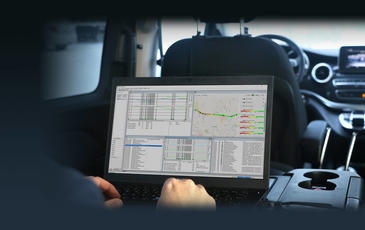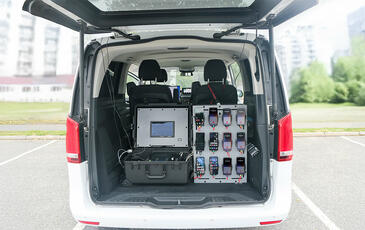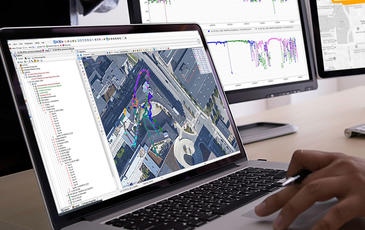5G Network Testing stands as a critical pillar in the deployment and optimization of fifth-generation wireless technology. As the digital landscape evolves, so do the demands for meticulous testing to ensure the performance and reliability of 5G Networks. Dive into our comprehensive guide to explore the methodologies, best practices, use cases, innovative solutions and more for 5G Network Testing.
What is 5G Network Testing?
5G Network Testing is the systematic process of evaluating and validating the performance of 5G Networks. 5G technology promises unprecedented speeds, ultra-low latency, and massive connectivity, revolutionizing industries and transforming the way we communicate and interact.
However, realizing the full potential and monetizing 5G requires meticulous testing across various stages of deployment and operation, from lab-testing environments to real-world scenarios. Network Testing is part of the engine that ensures that 5G Networks deliver on their promises, meeting the diverse demands of users and applications.
From validating network infrastructure to assessing end-user experiences, 5G Network Testing encompasses a wide range of methodologies and testing tools. It involves testing network elements such as radio access, core networks, and transport networks, as well as evaluating the performance of applications and services running on the network.
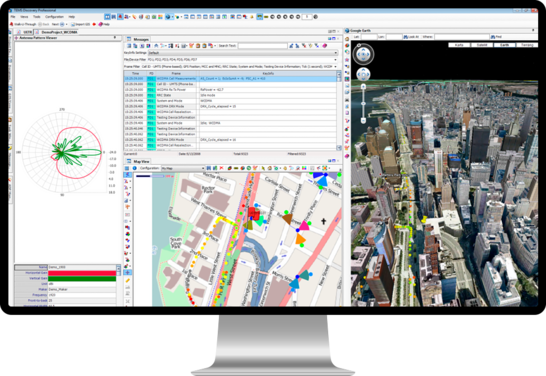
Why is network performance testing important for 5G?
5G network performance testing plays a pivotal role in the successful deployment and operation of 5G Networks. As the next evolution in wireless technology, 5G brings big opportunities for industries, applications, and digital innovation.
However, achieving the lofty goals of 5G requires meticulous attention to network performance. There are several reasons why:

With its promise of ultra-fast speeds and low latency, 5G users expect unparalleled performance across a wide range of applications, from augmented reality (AR) to autonomous vehicles. 5G User Experience testing ensures that these expectations are met, guaranteeing seamless connectivity and responsiveness for end-users.

5G is not just about faster smartphones; it's about enabling a multitude of use cases across industries, including remote healthcare, smart cities, and industrial automation. Network performance testing validates the network's ability to support these diverse applications, ensuring reliability, security, and scalability.

Different applications have varying QoS requirements, from high-bandwidth applications like 4K video streaming to low-latency applications like real-time gaming. Network performance testing verifies that the network can meet these stringent QoS demands, providing consistent and reliable service to users.
5G Network Testing challenges
Ensuring optimal performance and quality of experience (QoE) for 5G Networks involves addressing several key challenges:
- Testing interoperability: checking whether 4G and 5G components in NSA mode and O-RAN components can interoperate can be challenging. Lab testing is essential to validate these complex interoperability scenarios and ensure seamless integration.
- Testing MIMO and beamforming: these two aspects have major impacts on the QoE. However, it is not easy to validate the MIMO and beamforming performance of the network across different scenarios to determine the optimum configuration.
- Testing OTT apps: the performance of over-the-top (OTT) applications running on 5G Networks needs thorough testing to ensure the apps deliver the expected performance and reliability. A generic testing approach is the only feasible approach for the assessment of app performance on your network and optimized user experience.
- Testing 5G voice quality: ensuring high-quality voice calls over 5G Networks is critical. This requires advanced testing techniques to measure voice quality metrics and address potential issues such as latency, jitter, and packet loss.
5G Network Testing benefits for CSPs
Investing in 5G Network Testing yields numerous benefits for CSPs, such as:
- Performance enhancement: 5G Network Testing ensures optimal network performance, leading to faster speeds, lower latency, and improved reliability. This translates to smoother operations, increased productivity, and higher customer satisfaction.
- Cost savings: By identifying and resolving potential issues, 5G Network Testing helps CSPs avoid costly downtime, service disruptions, and performance bottlenecks.
- Increased efficiency: With the addition of centralized network management to 5G Network Testing processes, CSPs can minimize operational expenses and maximizes return on investment.
- Competitive advantage: CSPs that adopt 5G early and conduct thorough Network Testing gain a competitive edge in the market. They can deliver superior products and services, attract more customers, and differentiate themselves from competitors.
- Regulatory compliance: 5G Network Testing helps CSPs ensure regulatory compliance of their network.
- Scalability and flexibility: 5G Network Testing helps CSPs assess the scalability and flexibility of their networks, ensuring they can adapt to changing demands and growth opportunities. This agility enables CSPs to stay ahead of the curve and respond swiftly to market dynamics.
In conclusion, 5G Network Testing provides CSPs with a competitive advantage, cost savings, and support for innovation.
Overcome the challenges by navigating the 5G Network Testing evolution in cloud-native environments
Explore in this analyst report in collaboration with RCR Wireless the role that testing plays in ensuring service reliability and continuity amidst the shift to cloud-native and disaggregated networks. Discover essential testing strategies and the skills in high demand.
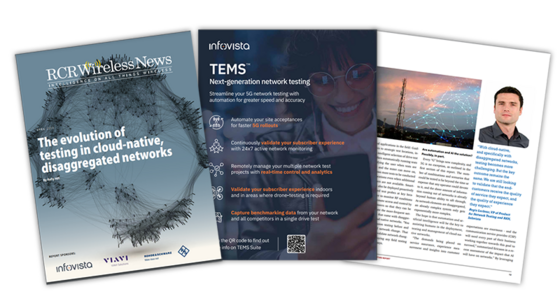
Deployment phases
During this phase, operators conduct preliminary testing to verify the readiness of the site for activation.
Testing focuses on assessing the coverage provided by the site aligns with expectations, ensuring it is not creating interference and validating all the mobility parameters have been correctly configured so the site will integrate seamlessly with its neighbors.
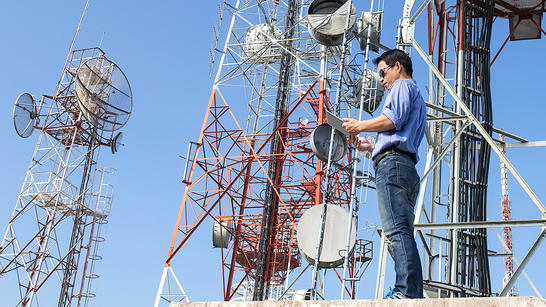

During this phase, operators conduct preliminary testing to verify the readiness of the site for activation.
Testing focuses on assessing the coverage provided by the site aligns with expectations, ensuring it is not creating interference and validating all the mobility parameters have been correctly configured so the site will integrate seamlessly with its neighbors.
In the site tuning phase, operators fine-tune the network infrastructure to optimize performance and coverage.
This involves conducting drive testing and walk testing to validate network performance and identify areas for improvement. Analysis of the testing logs helps engineers decide on site configuration and parameter adjustments to maximize network performance.


In the site tuning phase, operators fine-tune the network infrastructure to optimize performance and coverage.
This involves conducting drive testing and walk testing to validate network performance and identify areas for improvement. Analysis of the testing logs helps engineers decide on site configuration and parameter adjustments to maximize network performance.
The troubleshooting phase involves diagnosing and resolving issues that arise during network deployment and operation.
Operators use testing tools and techniques to identify network problems such as interference, coverage gaps, or poor performance. Once issues are identified, they implement corrective actions such as adjusting parameters, reconfiguring network settings, or replacing faulty equipment to resolve the problems and ensure optimal network performance.


The troubleshooting phase involves diagnosing and resolving issues that arise during network deployment and operation.
Operators use testing tools and techniques to identify network problems such as interference, coverage gaps, or poor performance. Once issues are identified, they implement corrective actions such as adjusting parameters, reconfiguring network settings, or replacing faulty equipment to resolve the problems and ensure optimal network performance.
Network Testing in 5G private networks
Building a 5G private network marks a significant milestone, but ensuring its reliability and performance is equally crucial before it becomes the backbone of business operations. Validating the functionality of these networks under real-world conditions is paramount.
Validating 5G private networks performance
Before entrusting a 5G private network with mission-critical tasks, you need to perform rigorous testing in scenarios that mirror their intended usage, ensuring that performance meets the highest standards. For this endeavour, TEMS™ Pocket enables you to evaluate a wide spectrum of network services, spanning from voice to video streaming to low-latency applications. Its portable nature allows for seamless deployment, whether it's conducting tests in remote locations or assessing network performance with drones in challenging environments.

What's new in 5G Network Testing?
Explore the latest TEMS updates, designed to enhance testing efficiency and data value—plus expert insights through blogs, videos, and webinars.

Next-generation Network Testing
The complexity of 5G Networks demands next-gen testing approaches, with three pivotal trends at the forefront due to the efficiency gains and cost savings they bring.

Centralized network management, combined with AI and automation
Centralized management addresses the complexity of modern wireless networks. Instead of individual engineers conducting isolated testing, centralized management enables engineers to focus on orchestrating, analyzing, and reporting on nationwide projects from a central location. By streamlining testing activities and providing real-time visibility, centralized orchestration minimizes wasted time and costly delays, ultimately reducing testing costs and increasing efficiency.
Infovista’s TEMS™ Cloud exemplifies the benefits of centralized 5G management. By centralizing orchestration and leveraging AI/ML-driven automation, TEMS™ Cloud transforms manual testing into an automated process accessible to a wider range of users, enabling operators to remotely orchestrate, monitor, and report on 5G Network Testing projects, maximizing efficiency in the field.

Drone testing for remote areas
The strategic deployment of drones for Network Testing is on the rise as mobile networks expand globally. These unmanned aerial vehicles (UAVs) offer a unique advantage in accessing and validating 5G network performance in areas where human access is limited or unsafe.
Equipped with TEMS™ Pocket-powered smartphones, drones enable efficient network assessment at varying altitudes, covering dense urban environments and industrial areas inaccessible to traditional drive test methods.

Generic testing techniques for OTT services
The emergence of 5G technology brings a flood of diverse services and apps, each with high demands on network performance. To tackle this, generic testing techniques are stepping up to the challenge.
How do they work? By using simple yet effective tools like generic OTT services and traffic patterns, they enable operators to test various services accurately and affordably. One major perk of generic testing is its cost-effectiveness. By focusing on network performance rather than individual apps, operators save time and resources. They can continually monitor and optimize the network without getting bogged down in testing every app separately. There are several fields in which this generic testing techniques can be applied, including:
Despite concerns about accuracy, Infovista has worked with standardization bodies to ensure the reliability of generic testing techniques. By mimicking real-world app behaviour closely, these techniques provide trustworthy results, helping operators improve network performance and user satisfaction efficiently.
5G Network Testing success stories
Numerous success stories highlight the effectiveness of 5G Network Testing solutions. Infovista's TEMS™ Suite addresses critical use cases that contribute to efficiency gains, cost savings, improved customer experience, and operational excellence.
Success stories
- A major European MNO uses TEMS to deliver its 5G Network
- Nokia automates drive testing to accelerate 5G roll outs
- BTC optimizes its mobile network with Infovista
- Qatar’s CRA measures regulatory compliance with TEMS
- Turning a regulatory task into a competitive opportunity
A major European MNO uses TEMS to deliver its 5G Network

A European tier 1 mobile operator confronted the challenges of rolling out its nationwide 5G Network. They needed an organization-wide view of how they deployed and optimized the network and that their teams couldn’t operate in silos. Powered by TEMS™ Suite, they could transform how all its stakeholders could support the central objective of providing and maintaining a 5G Network, from the lab testing team to the marketing team and more.
A major European MNO uses TEMS to deliver its 5G Network

A European tier 1 mobile operator confronted the challenges of rolling out its nationwide 5G Network. They needed an organization-wide view of how they deployed and optimized the network and that their teams couldn’t operate in silos. Powered by TEMS™ Suite, they could transform how all its stakeholders could support the central objective of providing and maintaining a 5G Network, from the lab testing team to the marketing team and more.
Nokia automates drive testing to accelerate 5G roll outs

In the race to deploy robust 5G Networks, Nokia had the focus on expediting the deployment of their 5G Networks. Nevertheless, the complexity of 5G made multi-site testing a costly and time intensive overhead.
To achieve their goal, they partnered with Infovista to accelerate 5G roll outs through cloud-based automated drive testing, enabling them to free Nokia engineers and service companies from manual drive testing to focus on high value network optimization tasks.
Nokia automates drive testing to accelerate 5G roll outs

In the race to deploy robust 5G Networks, Nokia had the focus on expediting the deployment of their 5G Networks. Nevertheless, the complexity of 5G made multi-site testing a costly and time intensive overhead.
To achieve their goal, they partnered with Infovista to accelerate 5G roll outs through cloud-based automated drive testing, enabling them to free Nokia engineers and service companies from manual drive testing to focus on high value network optimization tasks.
BTC optimizes its mobile network with Infovista

BTC operates Botswana’s leading nationwide 4.5G / LTE-Advanced network. They had the goal to modernize its existing mobile network and optimize the planning of future 5G-ready network infrastructure.
The network planning and testing solution, delivered by Infovista and complemented by Infovista’s partner MOZARK, is allowing BTC to test, benchmark and optimize the performance delivered by its mobile network, helping ensure that subscribers using connected services such as BTC Smega mobile money enjoy the best possible quality of experience.
BTC optimizes its mobile network with Infovista

BTC operates Botswana’s leading nationwide 4.5G / LTE-Advanced network. They had the goal to modernize its existing mobile network and optimize the planning of future 5G-ready network infrastructure.
The network planning and testing solution, delivered by Infovista and complemented by Infovista’s partner MOZARK, is allowing BTC to test, benchmark and optimize the performance delivered by its mobile network, helping ensure that subscribers using connected services such as BTC Smega mobile money enjoy the best possible quality of experience.
Qatar’s CRA measures regulatory compliance with TEMS

The Communications Regulatory Authority (CRA) for the State of Qatar had the goal to deliver multi-operator Network Testing during major global events hosted in the country.
To accomplish the task, the CRA selected Infovista’s TEMS™ Sense and TEMS™ Director to benchmark all of Qatar’s mobile operators and help ensure that they are continuing to deliver against their license obligations at times of peak traffic as subscribers and visitors attend large venues.
Qatar’s CRA measures regulatory compliance with TEMS

The Communications Regulatory Authority (CRA) for the State of Qatar had the goal to deliver multi-operator Network Testing during major global events hosted in the country.
To accomplish the task, the CRA selected Infovista’s TEMS™ Sense and TEMS™ Director to benchmark all of Qatar’s mobile operators and help ensure that they are continuing to deliver against their license obligations at times of peak traffic as subscribers and visitors attend large venues.
Turning a regulatory task into a competitive opportunity
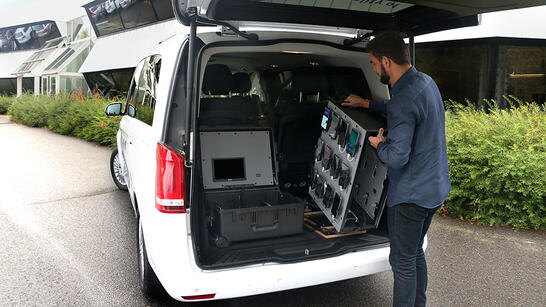
Following a merger between two North American mobile operators, the consolidated entity was required by the FCC to prove it met the specified 5G commitments and provide evidence that the network performance was consistent across the combined network.
To satisfy the regulator, the operator’s network engineers would have to drive over 1 million miles and conduct over 5 million tests. Nevertheless, powered by the TEMS™ Suite, they found the opportunity to turn this compliance-driven benchmarking from a regulatory cost into a competitive advantage.
Turning a regulatory task into a competitive opportunity

Following a merger between two North American mobile operators, the consolidated entity was required by the FCC to prove it met the specified 5G commitments and provide evidence that the network performance was consistent across the combined network.
To satisfy the regulator, the operator’s network engineers would have to drive over 1 million miles and conduct over 5 million tests. Nevertheless, powered by the TEMS™ Suite, they found the opportunity to turn this compliance-driven benchmarking from a regulatory cost into a competitive advantage.
Why choose TEMS™ mobile Network Testing solutions for your 5G Network?
Empowering 5G Networks demands a comprehensive approach to network testing that addresses every aspect of deployment and optimization. TEMS™ Suite from Infovista stands as a beacon of innovation and reliability, offering cutting-edge solutions tailored to the needs of modern telecommunications.
Discover how you can transform your 5G Testing with TEMS Solutions:
- Accelerate your 5G network deployment by streamlining lab testing, initial site tuning, cluster acceptance, and network troubleshooting, leading to swifter time-to-market.
- Ensure optimal network performance across all areas with a suite of cutting-edge solutions for drive testing, walk testing, and drone testing, providing comprehensive analytics and insights.
- Gain a holistic understanding of subscriber experience through state-of-the-art OTT voice and application testing capabilities, ensuring satisfaction and loyalty.
- Enhance competitor benchmarking efficiency with our innovative solution, enabling advanced network testing with minimal resources, utilizing just a single driver per vehicle.
- Proactively monitor your wireless network services around the clock with our automated remote network monitoring capabilities, ensuring uninterrupted performance and reliability.
- Get backed by 25 years of TEMS industry leadership. TEMS is trusted by mobile network operators and vendors globally, as well as awarded by Frost & Sullivan and other analyst firms, cementing its reputation as the foremost network testing solution provider.
Discover the TEMS™ Suite
TEMS Investigation
Perform drive tests to verify, optimize and troubleshoot all your mobile network technologies
TEMS Sense
Proactively monitor your wireless network services end-to-end with active testing
TEMS Discovery
Turn your network test data into analytics and actionable insights for optimization
5G Network Testing use cases
5G network testing is crucial for ensuring optimal performance, reliability, and user satisfaction. But how do its benefits translate into practical applications? Let's explore the key use cases where CSPs leverage 5G network testing and discover the best solutions for maintaining and enhancing 5G network quality.
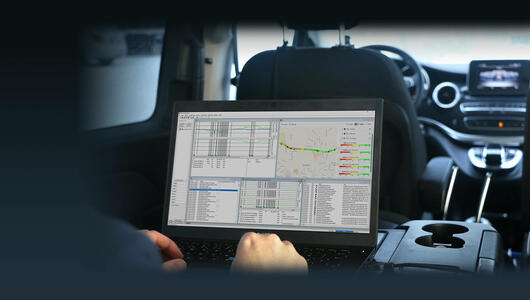
Mobile network troubleshooting and optimization involves drive-testing both new and existing cell sites to understand the experience your network delivers, identify and resolve issues, and make informed decision-making around future network investments.
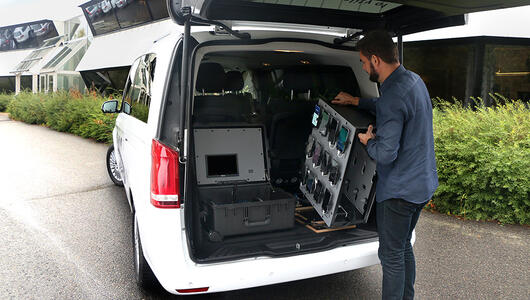
Competitor benchmarking enables you to compare your network quality to that of other mobile operators, in your home market. To measure subscriber experience across multiple operators, handsets, and services requires a drive test solution that is optimized for mobile network benchmarking projects.

UX testing enables you to innovatively combine various generic testing techniques, real live service traffic pattern emulations and machine learning (ML) algorithms to fully test your network and the user experience of any native or OTT applications and services running over them.

Indoor mobile Network Testing involves verifying, optimizing and troubleshooting your in-building network coverage so you can ensure your subscribers have a good quality of experience indoors.
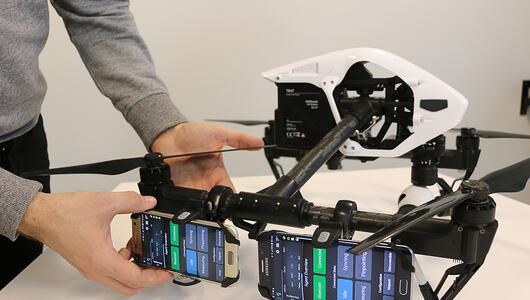
Drone-based mobile Network Testing provides a portable testing and troubleshooting solution to enable you to validate network performance in hard-to-reach places. It can also drive efficiency as it is often faster than walk testing when validating coverage in large areas.

Special event monitoring involves testing the quality of the network and gathering valuable data at large-scale special events where networks are typically extremely stressed.

Comprehensive Network Testing post-processing and analytics give you the ability to turn network test data into analytics and actionable insights for the optimization of your network performance.

Centralized test fleet management enables you to orchestrate, monitor and report on your Network Testing projects so you can plan and manage multiple projects across a variety of Network Testing solutions, all from a centralized back-office.

Strategic location monitoring enables voice and data service quality to be continuously monitored and validated across important locations in your network, such as your retail store network, to ensure that services are being provided at the highest possible level.

Private 5G network assurance uses automated remote network monitoring to continuously validate the performance of a private network.

Regression testing is the validation of network upgrades, new feature activations and any other changes that are made to the network to confirm they have either not adversely affected the network or have improved it as intended.
Get reference from 12 successful 5G Network Testing use cases
In the eBook “Evolving Network Testing”, discover real examples of how to efficiently operate a 5G network while facing any scenario and improving the accuracy of your testing routines.
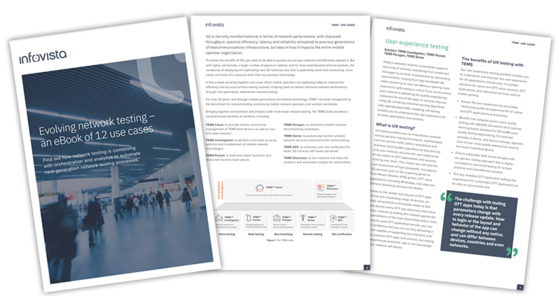
Get in touch
Building relationships is what we do best, we are excited to connect

